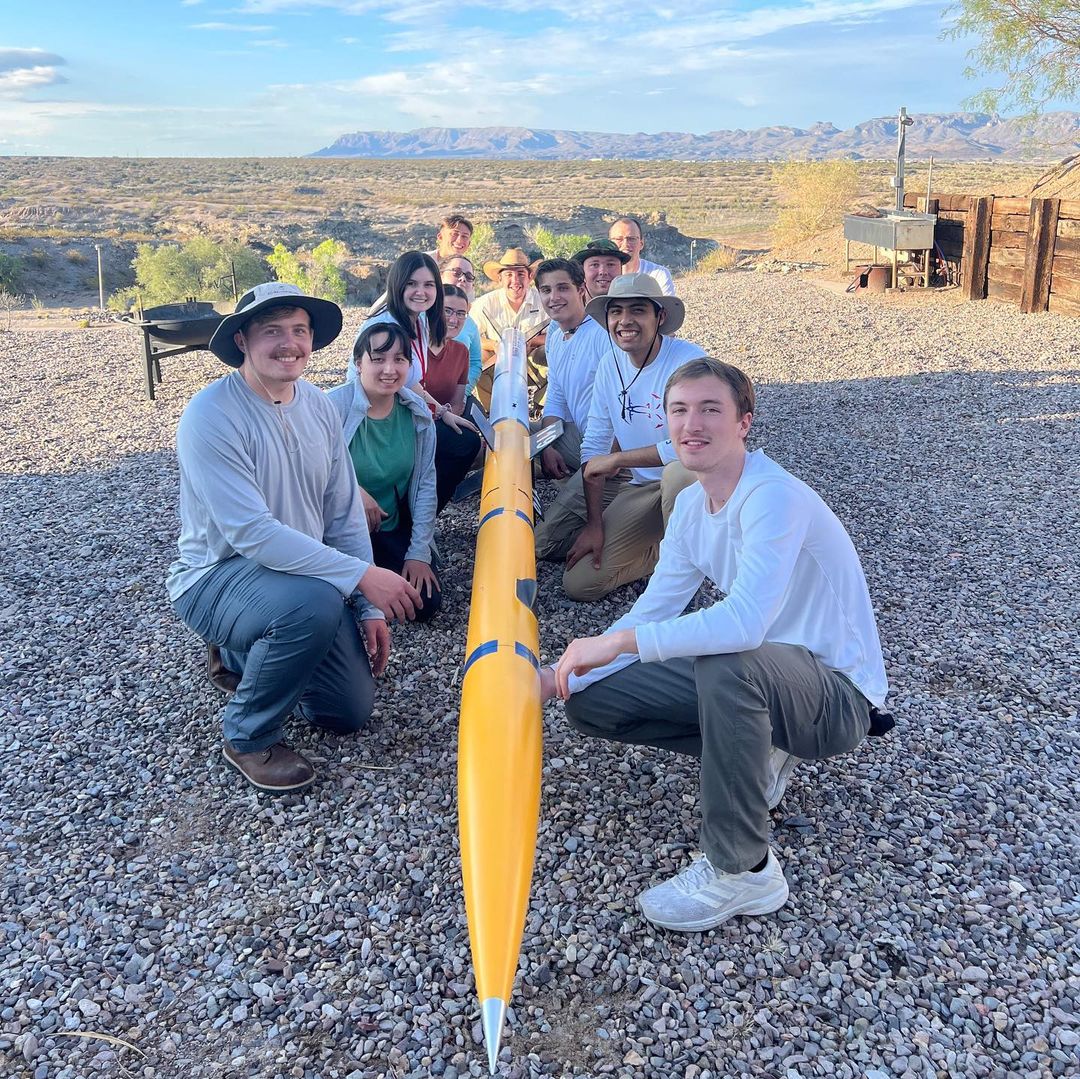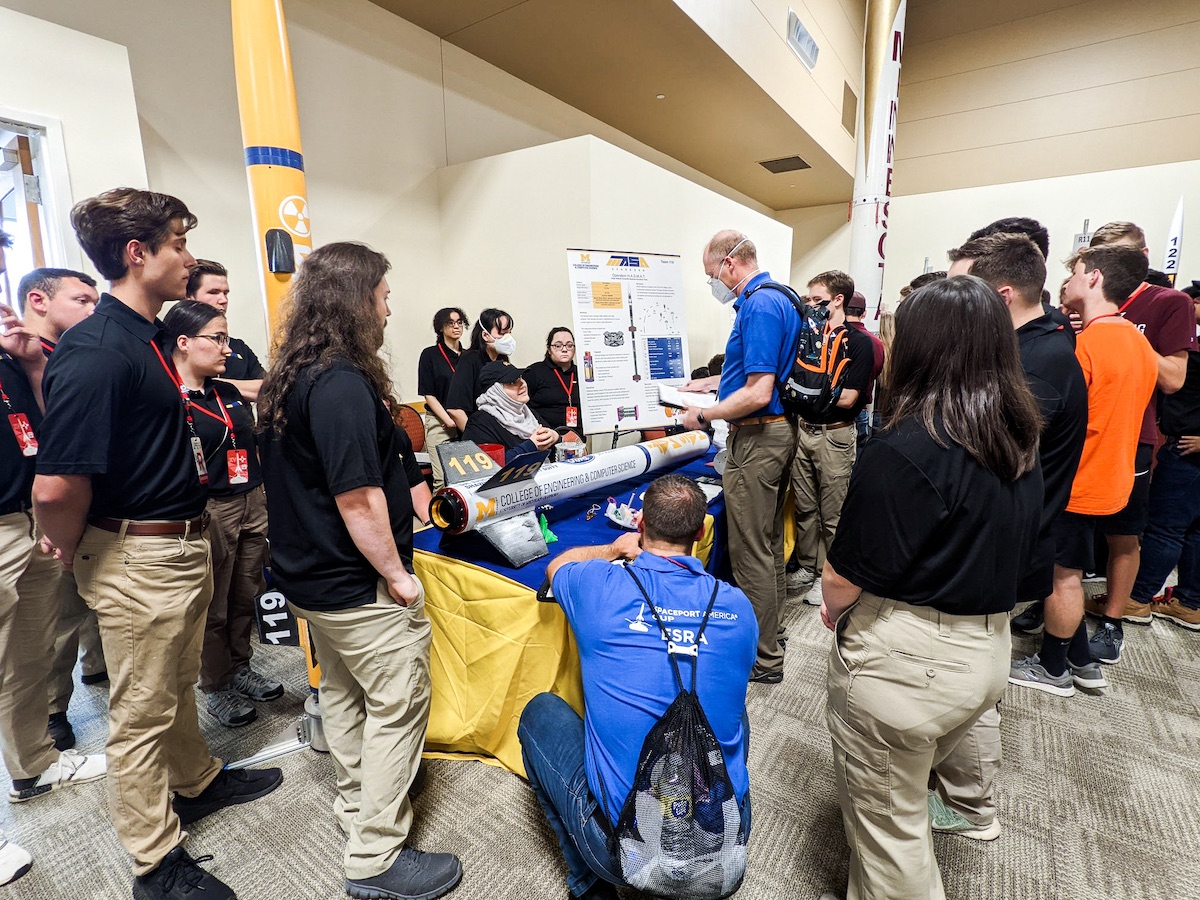
The Spaceport America Cup, held every year in a remote section of the New Mexico desert, is the Olympics for university rocketry teams. Every year, about 150 schools from more than 20 countries show up with rockets they’ve spent the past year designing and building and, if all goes well, they launch them tens of thousands of feet in the air. If all goes really well, they also recover them intact, along with their experimental payloads and valuable data. In a field where glitches are common, it’s not surprising that everything doesn’t always go as planned. As is the case with many new teams, UM-Dearborn's first trip to New Mexico in 2017 ended with a failed inspection. Some last-minute fixes the following year helped them clear that hurdle, but they never launched. Then, in 2019, they finally got off the ground, only to have their momentum immediately blunted by two years of the pandemic in which nobody launched. (UM-Dearborn performed well, though, in the virtual design competition held in 2021.) When organizers announced in-person competition would resume in 2022, no one on UM-Dearborn’s team knew if they were going to be able to pick up where they left off. But on the morning of June 24, after some weather and technical delays — lift off. Their rocket shot into the sky, achieved its target height of 10,000 feet, the recovery parachute deploying without a hitch. Except for a split-second moment of panic when the rocket briefly took a 90-degree turn right after launch, it was everything they’d hoped for.
When someone shouted that the chute had opened and the rocket had landed in one piece, Mechanical Engineering senior Jaimal Quezada could finally breathe. “You’re listening to the countdown and all you can think is, ‘I hope my system works, because I don’t want to let everyone down,’” says Quezada, who’d been thrust into the recovery lead role after another team member had to step back. The team ended up with an 11th-place finish in their category and placed 19th overall. They were also the judges’ pick for the Dr. Gil Moore Award for Innovation, beating out runners-up from a university in Thailand, another from the UK and Cornell University. The award is a really big deal for a team that's only been around for a few years. It's even more impressive when you consider the rocket team from UM-Dearborn has become a serious competitor without ever having a formal aerospace program to back it up with expertise and a steady stream of recruits.

The story of how the Michigan Aeronautical Science Association-Dearborn, or MASA-Dearborn (or usually just MASA), for short, seemingly sprung from nowhere is expectedly plucky and endearing. As then-Professor of Engineering Practice Line van Nieuwstadt remembers, it began with one student, Chris Bargman, who simply “came up to me one day and said he wanted to launch rockets.” Van Nieuwstadt, a NASA veteran who’d worked on communications systems for the Sojourner Mars rover project, only had two questions for him: “Where? And how high?” Such details were of practical importance. She knew that, given UM-Dearborn’s proximity to a major metropolitan airport, shooting rockets 10,000 feet in the air would face some immediate logistical challenges. It was also going to cost money. It took her about a year to line up the funding, which ultimately came from a strings-unattached gift the College of Engineering and Computer Science had recently received. It probably didn’t hurt that then-Dean Tony England, the final say on college budget matters, was a former NASA astronaut.
With funding in hand and van Nieuwstadt serving as the faculty adviser, Bargman rounded up some like-minded friends and they had all the core ingredients of a team. But they faced an obvious initial challenge: From a technical standpoint, building rockets was something that fell outside the college’s direct expertise. Faculty from the Mechanical Engineering and Electrical and Computer Engineering departments were happy to help with components and systems overlapping with their fields. But Associate Professor of Mechanical Engineering Eric Ratts, MASA’s current faculty adviser, says the real rocketry expertise ended up coming from an industry adviser named Robert Dickinson, who sort of adopted the team. Moreover, van Nieuwstadt knew that a real launch was still probably years away, and given the transient nature of college students, it would be crucial to establish a team structure that allowed them to continuously mentor new recruits. “My thought was that you would start as a freshman. Sophomores would make ideal team leads, and juniors would be team captains,” van Nieuwstadt explains. By the time students were seniors, she thought their upper-level classes and job searches would leave little room for transferring knowledge to the students coming up behind them, a dynamic that short circuits many student organizations.

Van Nieuwstadt also had a vision for the team becoming an experiment in equity. Women make up roughly 25 percent of students in engineering and computer science disciplines at UM-Dearborn, and it was slightly less when MASA got its start. Van Nieuwstadt encouraged the group to shoot for a goal of gender parity in its membership and leadership. Looking at the makeup of today’s MASA, there’s little doubt the students took her personnel strategies seriously. Today, female membership on the team is about 40 percent, and women have made up half of the team leads for the past four years. Mechanical Engineering senior Sierra Stockwell, who’s held several team lead positions and was president for two years, says the numbers tell just part of the story. For her, it’s also about the ways having more women on the team, and more women in leadership, have made MASA more inclusive for everyone. “When I joined, I felt very lost and unincluded,” Stockwell remembers. “The focus was on completing and launching the rocket above all else, and that left little room for educating and bonding with new members. When I became president, I wanted to make sure people didn’t feel uncomfortable asking questions, that they could be vulnerable with us, and they could tell us if something was wrong. I think my inspiration was thinking back to how I felt when I joined the team, and not wanting to feel like I was this helpless new member. I would say to everyone, ‘Before we build a rocket, we have to build a team.’ And when we allowed for this you-trust-me, I-trust-you, we-take-care-of-each-other dynamic, I think that made people more comfortable. It also made us work harder, because people felt like if something were to happen, there was no shame in asking for help.”
The approach has definitely paid off. Mechanical Engineering senior John Florn’s dream is to work in the automotive industry as a systems testing engineer. But when he was looking for a student team to gain some hands-on experience, he chose MASA over some more automotive-focused teams because of the “good vibes.” Biology senior Perla Fares joined MASA with exactly zero engineering experience, but quickly found her niche when other team members encouraged her to design the scientific payload experiments. (This year, she was also the team's project manager). For Quezada, he just prefers working on a team that has gender balance. “It is difficult to work with all men — I feel like I can say that because I’m a guy,” he says, laughing. “I remember this one time in Engineering 100, I was working in a group with all men, and the professor gave us this problem to solve. And immediately, it was like everyone was jockeying for power, trying to prove their idea was the best idea. I think having a good representation of men and women keeps everything balanced and everyone gets heard.”
Ratts thinks this kind of mutual respect also makes their work better. “Even when they aren’t working on their rocket, you’ll see them in the lab, and it’s clear they’ve become a tight group of friends,” he says. “They study together, they help each other out, and having developed those relationships, when they’re focused on a competition, I think it helps them work harder. If you’re the one in charge of a particular component or system, you really want it to work, because you don’t want to let your friends down.” Ratts and van Nieuwstadt say, at times, they have worried that the team dynamic is almost too good, noting that the students’ drive and determination to work on their rocket sometimes borders on interfering with their studies. There could be an obvious remedy for that — namely, if the college explored starting a formal aerospace engineering program. Van Nieuwstadt doesn’t think that’s so far out. “I think it’s actually pretty common for programs to get started because you see interest among students, or maybe a new industry that needs workers,” she says.
In fact, she wouldn’t stop dreaming there. Looking at MASA, she actually sees the seeds of a small aerospace industry in southeast Michigan. All the ingredients are there: alums of the team who are now working at NASA and SpaceX and Raytheon, gaining real-world experience; a generation that’s highly entrepreneurial; a group of likeminded people, bonded by formative experiences, who stay in touch via a growing LinkedIn network. Perhaps most importantly, she thinks a lot of them may not want to stay in Texas or California or Virginia forever. “That’s the challenge right now: If they want to work in the industry, they have to leave. But so many of our graduates actually want to stay in the area. So what happens when, say, 20 of them end up at SpaceX, and they get to talking about the cost of living in California versus Michigan, or how they’d like to be closer to family? That’s how companies get started. And if Dearborn had a program, they’d have people ready to work there. Isn’t that a lovely vision for the future?”
###
Story by Lou Blouin



